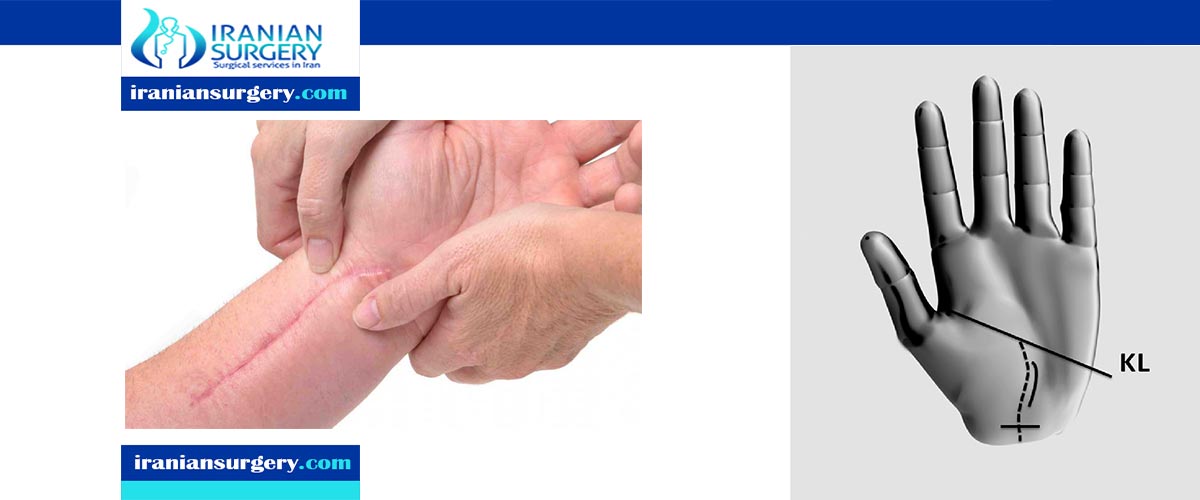Carpal tunnel surgery scar

Does carpal tunnel surgery leave scars?
How long does carpal tunnel Scar take to heal?
Pain after Carpal tunnel surgery
How to treat a scar?
What is the average recovery time for carpal tunnel surgery? How do you treat the incision after carpal tunnel surgery?
The risk and complication rates of open surgery are very low. Major problems such as nerve damage happen in fewer than 1 out of 100 surgeries (less than 1%). There is a small risk that the median nerve or other tissues may be damaged during surgery. After open surgery, recovery may be slower than after endoscopic surgery. And there may be some pain in the wrist and hand. You may also have some tenderness around the scar. There are also the risks of any type of surgery, including possible infection and risks of general anesthesia. But most open carpal tunnel surgery is done with local anesthesia or regional block rather than with general anesthesia.
Scar tissue on the skin surface can be unsightly and destroy the beauty of the natural anatomy, but the scar tissue below the surface in the muscle tissue, around the tendon sheaths and fascia tissue and in the transverse carpal ligament can be a lot more problematic from a functional point of view. Scar tissue can limit movement and be the source of permanent tenderness and permanent loss of grip strength and it can create pressure on the Median Nerve.
Scar tissue is the most common reason that Carpal Tunnel Symptoms, such as hand numbness, hand pain and wrist pain gets worse after surgery than before surgery. This worsening of the Carpal Tunnel Condition happens to about 4-8% of people post-surgery.
Sometimes carpal tunnel scar tissue will result in the same symptoms post-surgery as before.
Once scar tissue has formed there is not a lot that can be done from a surgical point of view. More surgeries will only create more scare tissue exacerbating the issues with discomfort, pressure on the nerve and pain from movement.
A person with arthritis is likely to generate more scar tissue than a person without arthritis, and runs a much higher risks of complications with a surgical procedure.
Read more about: Carpal Tunnel Surgery
Read more about: Knee Replacement Surgery
How to treat a scar
If you have a scar that is causing pain or is limiting the use of your hand or arm, a hand therapist can help using the following treatments:
- Scar massage: Normal skin can be lifted and moved in all directions. Massaging the scar helps the scar move the same way as the normal surrounding skin. Using lotion helps as you massage your scar in circles, side to side, and up and down .This stretches the skin in all directions to reduce the tightness of the skin while it is healing. This also helps to decrease sensitivity of the skin and provides necessary moisture for healing.
- Scar pads and tape: Silicone pads offer compression and help to soften the skin resulting in a flat and less noticeable scar. A silicone pad is applied like a sticker to the skin. Your hand therapist can discuss wear (usually overnight). If your scar is irregularly shaped and/or deep, a silicone-based elastomer can be molded to your scar. Either silicone or elastomer scar pads can be held in place. When the scar is hypersensitive it is important to introduce different textures to the skin to decrease sensitivity. Start with something soft you can tolerate like a pillow case. Rub the hypersensitive area for one to two minutes at a time. Work up to more abrasive textures like a washcloth several times per day.
Read more about: What is Ankle Arthroscopy Surgery?
Read more about: How to sleep after knee arthroscopy?
Read more about: Hip Replacement Surgery
Does carpal tunnel surgery leave scars?
After the ligament is cut, the skin is closed with stitches. The open procedure for releasing the carpal ligament involves a sizeable wrist incision, usually about two inches long.
How long does carpal tunnel Scar take to heal?
The recovery from carpal tunnel surgery takes time anywhere from several weeks to several months. If the nerve has been compressed for a long period of time, recovery may take even longer. Recovery involves splinting your wrist and getting physical therapy to strengthen and heal the wrist and hand and It may take weeks or months to fully treat your scar. A hand therapist can guide you during this process to improve motion, decrease pain, and gain strength to return to you to your daily activities as quickly as possible.
Read more about: ACL Repair Surgery
Read more about: Shoulder Replacement Surgery
Read more about: Laminectomy Surgery
Pain after Carpal tunnel surgery
In the treatment of Carpal Tunnel Syndrome, recovery periods are extremely variable. This is because damaged nerves have slow and variable rates of regeneration. While the recovering nerve regenerates, you may still feel symptoms in your fingers, even after surgery.
10 common question about carpal tunnel surgery scar
[kkstarratings]

